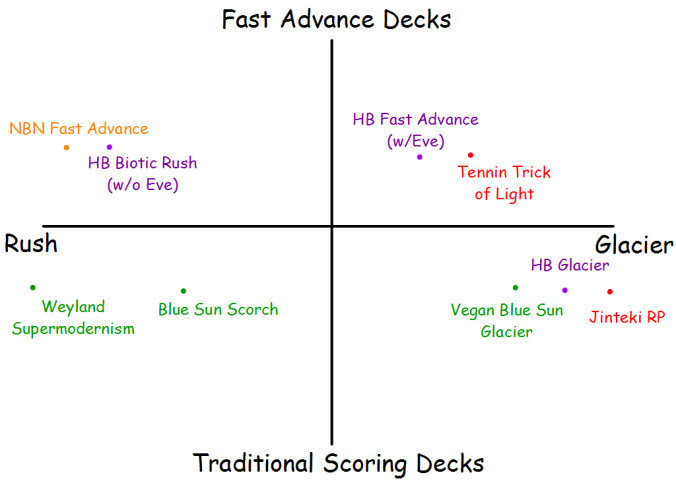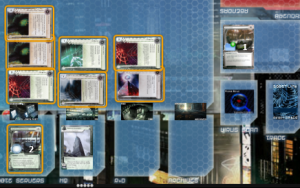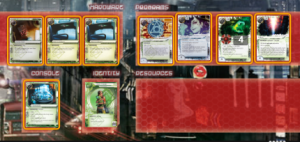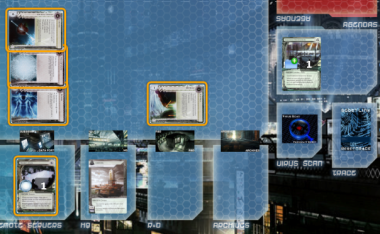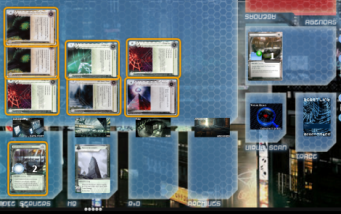For this article I thought I would try to talk through my thought process behind building what I believe to be quite a good deck. I feel the idea behind this deck was particularly inspired, and a discussion of how I landed on my exact choices could be interesting.
Before I start, I should say that many of the ideas from this deck were inspired by my online games and discussions with a couple other players:
Mason Hans (Eldermason) for his use of ELP alongside a multitude of HB assets.
Sam Suied (SamRS) for several of the other synergies in the deck, particularly those surrounding Clone Suffrage Movement.

The first synergy that inspired this deck was that between a protected Advanced Assembly Lines and political assets (Like the in-faction Clone Suffrage Movement). Having ICE on your Assembly Lines means that you can install your Clones at the end of the runner’s turn, allowing you to guarantee a trigger on yours. This also compresses the runner by 1 click on their next turn because they will almost certainly want/need to deal with the CSM.
To further take advantage of this click compression, it makes sense to run Enhanced Login Protocol. This card is already a great tool against Criminals and Whizzard, especially now that they all have 3 Temujin Contract. Being able to sometimes recur the ELP with CSM is a nice bonus.
A lot of HB decks don’t typically run a lot of Operations, and I want to be able to always have an immediately useful target for my Clones, so Lateral Growth makes sense as an addition. With 3 Assembly Lines and 3 Laterals, Blue Level Clearance seems excellent, since if I have one the former cards I can even play it on turn 1 without having to discard, which is really nice. Lateral a Clone Suffrage Movement, Ice a central, play ELP is an amazing first turn. Often the CSM will go unchecked and recur the lateral to give me a great start to the game. Following up with a Blue Level into the Lateral on the next turn makes me salivate just thinking about it.
To maximize the ELP, it also makes sense to run some more assets, but since I already have 9 economy cards and the Engineering the Future identity, I can afford for them to be utility assets. Team Sponsorship has incredible synergy with must-trash and self-trashing assets like Assembly Lines and Clones, allowing me to double-down on their effects every time that I score. Since I have Blue Level Clearance and Lateral Growth, and since this is starting to look like a Fast-Advancing deck, Jeeves Model Bioroids seems like a good fit. 3 copies would probably be too many since it is unique it is less likely to get trashed when I have so many other high-priority assets and ELP, so I’ll go with 2. Now that I know I’m fast Advancing, 3 Biotic Labors are necessary. Shipment from Sansan also seems nice to have, but probably not 3 copies. I’d come back to that one.
Now for the ICE suite. Gearcheck ICE has great synergy with our click-taxing game-plan. Ideally the runner will not have much time to draw for their breakers since they will have to deal with high-threat cards under an ELP on a regular basis. I definitely want 3 Vanilla, since it’s the best barrier gear-check in the game (certainly for HB at least). 3 Architect also seems obvious with our volume of assets.
At this point I had a great realization. With so many people going to Yog.0, and with our emphasis on gear-checks, a couple Lotus Fields seems like a great choice. When I run the lotus I usually like to run another smaller Code Gate alongside it for the match-ups where Lotus isn’t worth the cost. I like Magnet a lot more than Enigma right now, since you can punish the Criminals who have Passport (3 credits) and Peacock (4 credits), and Parasite immunity is a nice bonus. We actually have 7 ICE with this property which is quite impressive. I’m not too worried about losing our Vanillas to the excess Parasites, since they cost nothing and can easily be reinstalled with Team Sponsorship if we want.
For the agendas, I’m going to default to a 9-agenda suite rather than an 11-agenda suite since I don’t want it to be too easy for the runner to steal something and turn off our ELP. Global Food Initiative is also great to jam behind a Lotus Field against the decks that struggle to break it early.
This was my deck so far:

At this point we need a smart way to spend our last 5 influence. It seems like a Sansan City Grid could be a nice Luxury. Reinstalling it with Sponsorship is brutal. I already mentioned Shipment from SanSan as a potentially useful card, so we’ll slot one of those for our final pip.
Now we need a little more ICE. Ichi 1.0 into Vanilla is one of my favorite taxing-on-a-budget servers, and ELP makes it even better, since if they click the Ichi they will have to eat the trace with no clicks remaining. 3 Ichis is probably too many though, so we’ll go with 2. I also want one more hard Sentry because of the recent prevalence of Mongoose. Rototurret isn’t great, but this sort of tempo deck is its natural home, so I’m willing to try a single copy. Architect into Rototurret could end in a blowout against a Mongoose deck if the runner decides to take a risk. With how many cards we will be drawing (both with clicks and with Blue Level Clearance), 13 ICE should be enough. We also will often not make a multi-ICE remote server, or even an ICE’d remote server at all, which certainly helps. Now I was at 48 cards with all needs accounted for, so I added a pet card of mine that has actually made a massive difference in many of my victories.

Domestic Sleepers lets us win from 6 points while only on 1 credit. It triggers Team Sponsorships, and we can even triple click it to go up to 5 points and get a click back from Jeeves (not actually a big deal, but it’s quite funny)! Here’s the final list (Efficiency Committee was my 4/2 for a while, but Sales Team has clearly been better in further testing so I’ve made the switch retroactively here.)
https://netrunnerdb.com/en/decklist/38094/thebigboy-s-sleeper-hold
Sleeper Hold
Haas-Bioroid: Engineering the Future
Agenda (10)
3x Accelerated Beta Test
1x Corporate Sales Team
1x Domestic Sleepers
2x Global Food Initiative ●●
3x Project Vitruvius
Asset (13)
3x Advanced Assembly Lines
2x Clone Suffrage Movement
3x Jackson Howard ●●●
2x Jeeves Model Bioroids
3x Team Sponsorship
Upgrade (1)
1x SanSan City Grid ●●●◦
Operation (12)
3x Biotic Labor
3x Blue Level Clearance
2x Enhanced Login Protocol
3x Lateral Growth
1x Shipment from SanSan ●
Barrier (3)
3x Vanilla
Code Gate (4)
2x Lotus Field ●●
2x Magnet
Sentry (6)
3x Architect◦◦◦
2x Ichi 1.0
1x Rototurret
At this point I looked at my deck and thought…
“What a pile of shit.”
And then I realized…
The deck has 0 Hedge Funds.
This was going to be a disaster.
The deck looked like it should lose to every reasonable runner deck. Nevertheless, it looked like fun so I played some games on Jinteki.net just to see if I could squeak out some wins.
It stomped.
Most games were not even close.
Between unanswered Lotus Fields, oppressive ELP openings, and just straight-up Biotic Labor spam, the deck just kept winning. I kept jamming games with it, day in and day out, confident that eventually my losing streak would begin and I could move on to something else, but this never happened. As the caliber of my opponents increased the games certainly got much closer, and a few games slipped away from me, but I was still winning FAR more than I had been with any other Corp deck.
There is something here. It’s weird, it’s powerful, and I’m not really sure why…
I think the essentially click-less economy cards like Assembly Lines and Lateral Growth are actually much stronger than they look. Being able to make some credits without having to slow your pressure of drawing cards and creating threats is a really unique effect that has only recently snuck its way into the game.
Cards I am interested in trying at some point are: 1 copy of Subliminal messaging, 1 Fast Track, the 3rd CSM, and possibly even the 3rd ELP, but I need far more games to decide what I can afford to cut. I am confident that all of these options are worse than my precious Sleepers. The Rototurrent is obviously not incredible, but I’m hoping a strong HB ICE comes out in the next few packs so I can replace it. I really don’t want to go below 13 ICE, and don’t want a porous ice like the 3rd Ichi 1.0.
After a period of Corp play so depressing that I built a Mushin No Shin deck for my last article, I am finally having fun again!
I hope you enjoy this deck if you decide to try it. I’ve been told that it takes a few games to get used to, so stick with it if you’re not successful at first. Having 9 non-Hedge Fund burst economy cards certainly takes some getting used to. Drop a comment here or message me on the Stimhack forums or Slack chat if you have any questions about the deck!
-TheBigBoy
